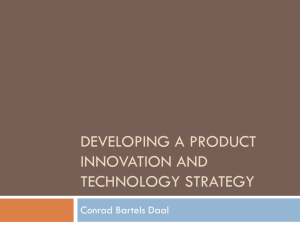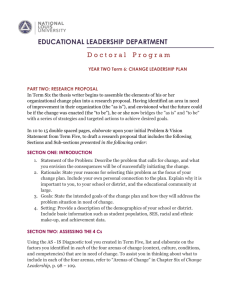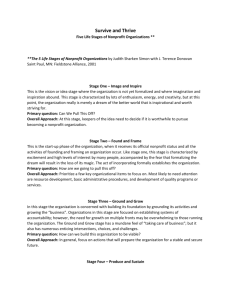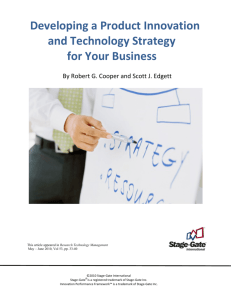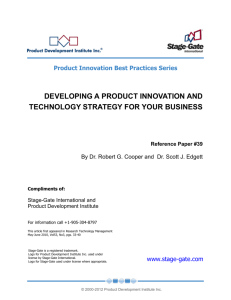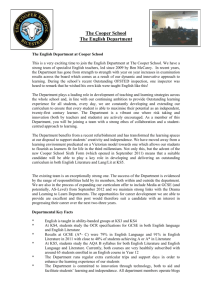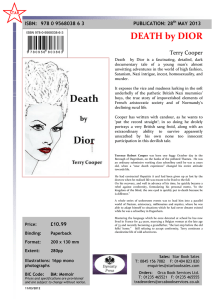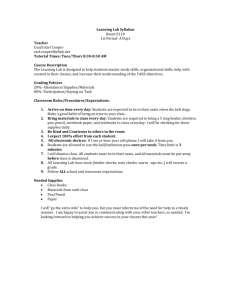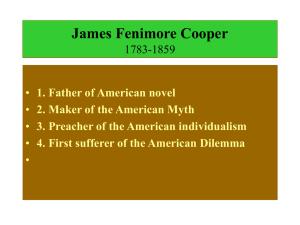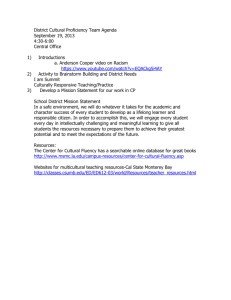A Framework for Developing a Product Innovation and Technology
advertisement
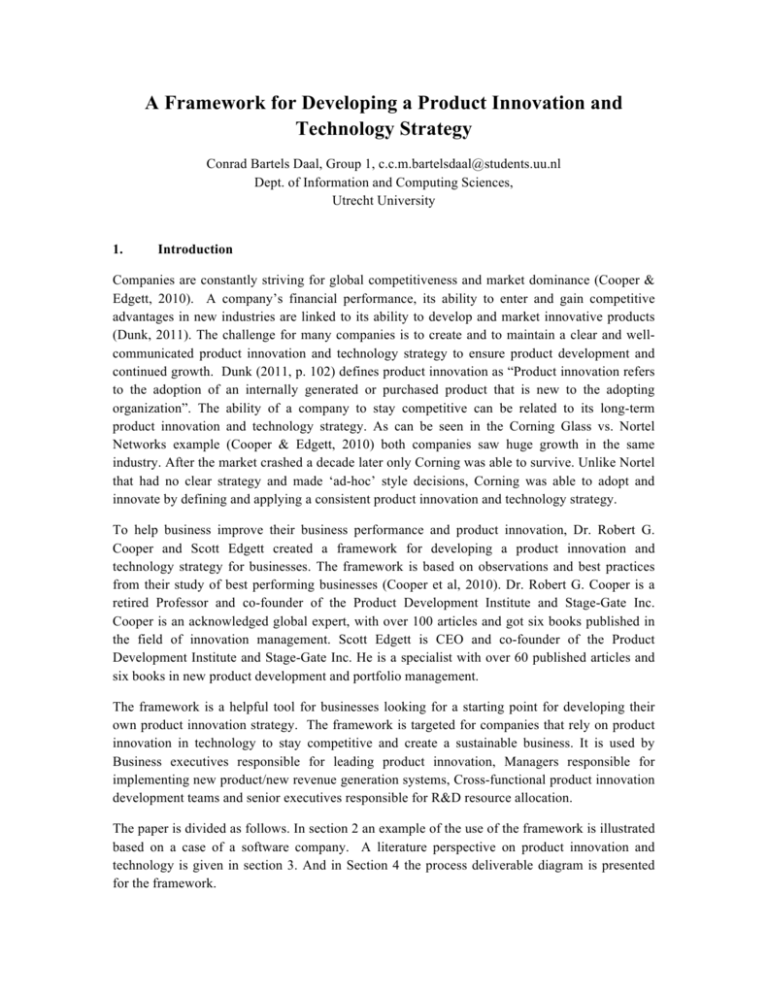
A Framework for Developing a Product Innovation and Technology Strategy Conrad Bartels Daal, Group 1, c.c.m.bartelsdaal@students.uu.nl Dept. of Information and Computing Sciences, Utrecht University 1. Introduction Companies are constantly striving for global competitiveness and market dominance (Cooper & Edgett, 2010). A company’s financial performance, its ability to enter and gain competitive advantages in new industries are linked to its ability to develop and market innovative products (Dunk, 2011). The challenge for many companies is to create and to maintain a clear and wellcommunicated product innovation and technology strategy to ensure product development and continued growth. Dunk (2011, p. 102) defines product innovation as “Product innovation refers to the adoption of an internally generated or purchased product that is new to the adopting organization”. The ability of a company to stay competitive can be related to its long-term product innovation and technology strategy. As can be seen in the Corning Glass vs. Nortel Networks example (Cooper & Edgett, 2010) both companies saw huge growth in the same industry. After the market crashed a decade later only Corning was able to survive. Unlike Nortel that had no clear strategy and made ‘ad-hoc’ style decisions, Corning was able to adopt and innovate by defining and applying a consistent product innovation and technology strategy. To help business improve their business performance and product innovation, Dr. Robert G. Cooper and Scott Edgett created a framework for developing a product innovation and technology strategy for businesses. The framework is based on observations and best practices from their study of best performing businesses (Cooper et al, 2010). Dr. Robert G. Cooper is a retired Professor and co-founder of the Product Development Institute and Stage-Gate Inc. Cooper is an acknowledged global expert, with over 100 articles and got six books published in the field of innovation management. Scott Edgett is CEO and co-founder of the Product Development Institute and Stage-Gate Inc. He is a specialist with over 60 published articles and six books in new product development and portfolio management. The framework is a helpful tool for businesses looking for a starting point for developing their own product innovation strategy. The framework is targeted for companies that rely on product innovation in technology to stay competitive and create a sustainable business. It is used by Business executives responsible for leading product innovation, Managers responsible for implementing new product/new revenue generation systems, Cross-functional product innovation development teams and senior executives responsible for R&D resource allocation. The paper is divided as follows. In section 2 an example of the use of the framework is illustrated based on a case of a software company. A literature perspective on product innovation and technology is given in section 3. And in Section 4 the process deliverable diagram is presented for the framework. 1.1. Product Innovation and Technology Strategy Framework The framework consists of five main activities as summarized in Figure 1. First, the goals for the new product development are defined and are tied into the broader business goals. Important here is to make sure that the new goals are clearly communicated to all stakeholders. The next step defines the different strategic arenas (market, technology etc.) on which the business will focus its new product efforts. Fundamental to the strategic thrust of the business’ product development effort is to specify the ‘in bounds’ and ‘out of bounds’ of the strategic arenas for the product innovation. The product-market matrix is used to define new arenas in which they can operate profitably. Next the arenas are evaluated by a set of 6-8 questions, which senior managements then uses to rate the various arenas under consideration based on two dimensions: Area of attractiveness and business strength. The result is a strategic map that plots the different potential arenas. With the strategic arenas selected, idea generation becomes more directed and productive. Figure 1. Product innovation and technology strategy framework After the strategic areas are identified a plan must be made on how to attack each strategic arena. Understandings of the business’ core competencies coupled with knowledge of industry success drivers are key factors in the selection of the appropriate attack strategy (Cooper et al. 2010). For each new arena entry strategies are defined. The next step determines important development decisions on spending, resource commitment and allocation. Development projects need to be aligned with business strategy to ensure effective portfolio management. To achieve this, the strategic bucket method is used. A bucket represents each project type or market geographic area. Projects within buckets are ranked and funded in rank order until that bucket runs out of resources. When the strategic-bucket method is followed over a longer term the result here fore is an optimal portfolio of projects, one that mirrors the strategic priorities of the business. Finally management makes tactical portfolio decisions on project prioritization and selection to insure that resources are allocated to the right projects to achieve all product innovation business goals. 2. Mobile Software Company Example A software company build on the success of a personal finance management application launched 5 years ago is losing market share to new competitors. The new competitors are copying their initial product and services and providing them on a mobile platform. Senior management has recognized the los in revenues and customers and called for a new innovation plan to solve this problem. To create a new product innovation a technology strategy senior management has formed a team of managers, executives and developers to head up this initiative. This team will use the framework for creating a product innovation and technology strategy to develop the company’s new innovation strategy. This new strategy must make the software company innovative market leader once again. The following example steps will illustrate the use of the framework for creating a product innovation and technology strategy for a business. 2.1. Define Goals and Objectives The first step is to define the goals and objectives of the new product development. The example shows that the software company had a successful product but is still loosing market share to new competitors. The business strategy clearly is to become market leader again. An example of business goal that fits into this strategy is to “Gain 40 % of the mobile market within 5 years”. The product innovation objectives should fit into this business strategy. The management team should ask questions like: How do new products and product innovation fit into the business’s overall plan? Examples of product innovation goals and objectives that the management team can set are: 1. Research and development of mobile versions of the personal finance management application. 2. Sales generated of new products must be 20% of total sales in the first year 2.2. Select Strategic Arenas After defining the product innovation goals and objectives, the management team will define the strategic arenas. These strategic arenas will define what is ‘in bound’ and ‘out of bound’ for product innovation. A product-market matrix is used to identify new profitable opportunities for the business. A template is shown in Appendix 1.Product-Market Matrix. The management team will use the product-market matrix to defines possible strategic arenas on which to focus new product development or R&D efforts. The product-matrix for this example can be seen in Table 1. The management team will evaluate these arenas and create a strategic map to define the arenas where the business should focus its product development resources. A template is shown in Appendix 2.Strategic Map. Market/Product Data synchronization Cloud computing Integration of services Mobile users Home users Mobile and Home Users X X X X X Table 1. Product-market matrix X X 2.3. Develop Attack and Entry Strategies With the strategic arenas defined, the management team will then define different attack plans for each area. The company wants to be a market leader so its attack plan will be to be an Innovator and first-to-market to ensure its market dominance. Furthermore, its entry strategy will be to develop on the newest mobile technologies (e.g. tablets, pay-with-your phone, etc.). 2.4. Strategic Portfolio Decisions Important to the realization of new product innovations is the allocation of resources to these new projects. One of the product innovation goals set in the first step (see section 2.1) was “To have 20% sales generated from new products by the first year”. To achieve this goal resources must be strategically allocated to support the new product developments. A resource allocation of 40% to new product developments, 20% to current development, 10% improvements & modifications of current products will insure that the goal will be met. The creation of a strategic product roadmap is a crucial step in strategic portfolio decision-making. A strategic roadmap is an effective way to plot a series of major initiatives in the attack plan (Cooper & Edgett, 2010). The roadmap is an effective way to communicate all major steps in the attack plan. It will be used to communicate the strategy to senior management, who will give the go no/go decision. An example of a strategic roadmap created by the management team can be seen in Figure 2. Figure 2. Strategic Product roadmap 2.5. Tactical Portfolio Decisions The last step is project tactical portfolio decisions. This step is bases on project selection and prioritization. Management has to allocate resources to projects in the portfolio based on prioritization and go/no tactical decisions. The company’s available resources must be allocated to the project with the highest priorities and overall success chances. The software company in the example will allocate more resources to projects that aim at mobile development. 3. Literature perspective The framework for developing a product innovation and technology strategy is based on different methods that once used in a specific order following a set of principles and guidelines, which will produce good strategies for businesses. The root principles are derived from innovation management. Verloop (2006, p. 6-8) defines innovation as “A supply chain process and the essence of effective innovation management is to understand that the path from idea to market goes through three distinct stages: generating and conceptualizing ideas, developing and demonstrating the concepts, and investing to extract the value from the market place”. The product innovation and technology strategy framework is developed for company-based innovation and is based on the three stages of innovation. The idea generation and crystallization stage is about generating ideas and developing them into a concept that can be communicated and discussed. The first step in the framework adopts this idea and specifies that the goals must tie into the broader business goals. The next step is the concept development phase, which includes identifying the link with the market and customers’ needs and the value to the stakeholders. The framework has also adopted this step where it defines the different strategic arenas of focus. The Development and demonstration stage develops the concept and assesses its feasibility in all aspects. The development plans have to be adjusted regularly in view of new findings .The more radical the new idea is, the more difficult this is. The framework has adopted this step in a more practical project view. Where it determines important development decisions on spending, resource commitment and allocation that align with business strategy. The Investment and preparing for launch stage involves creating the capabilities in the company that are needed to launch the product or service into the market. This step is out of the scope of the framework that only creates a strategy. The second key principle of the framework is technology strategy. The framework does not only develop a product innovation strategy but also positions and exploits this product in the development of technology over time. The core of a company is not the product that it has or the markets it serves, rather what is knows and what it can do (David, 1998). Technology strategy centers on this knowledge and abilities. The framework applies this strategy by developing policies, plans and procedures for acquiring knowledge and ability. The goal is to manage that knowledge and ability within the company to exploit them for profit. Import to product innovation is technology and product road mapping. Kostoff & Schaller (2001, p. 132) define a roadmap as: “A roadmap is an extended look at the future of a chosen field of inquiry composed from the collective knowledge and imagination of the brightest drivers of change in that field”. Roadmaps are used to communicate visions, attract resources from business, stimulate investigations and monitor and plan progresses. Roadmaps can take various forms but they all try to answer three simple questions: (1) where are we going, (2) where are we now, and (3) how can we get there? (Phaal, Farrukh, & Probert, 2005). The success of production innovation goes beyond the strategy used by the business. Dougherty & Hardy (1996, p. 1146) conclude from their research that “Product innovation, when it did occur successfully, was powered by the operational and middle levels of the organizational hierarchies and based largely on the particular networks, connections, and experiences of lower-level managers”. Tidd (2001, p. 180) states, “The complexity and uncertainty of the environment affects the degree, type organization and management of innovation”. As we can see in the literature, the factors for a company’s success are a good product innovation strategy and a dedicated and consistent management team to execute and maintain this strategy. Research done by (Li & Atuahene-Gima, 2001) supports this view. The research was done on product innovation strategies and new technology venture performances in China concluded that the relatively low amount of variance in performance found suggests that other factors affecting new technology venture performance in China are influencing the performance. The research further explains the key factor of a good management team by suggesting that a possible area of research would be the impact of founder or top management team characteristics. Different management visions and business strategies will lead to different innovation goals as can be seen in de research by (Roper, 1997). Research was done on product innovation strategies of German, U.K and Irish companies. The companies had similar product innovation objectives but the innovation strategies significantly varied. Management in Germany had a more riskreeducation/cost-sharing networking strategy that lead to emphasis on mutual or collaborative ventures. Further R&D was more formally organized in German companies than in the U.K. and Ireland. This again suggests a more managed or planned approach to product innovation by German companies compared to the less formal, more market responsive pattern of U.K. and Ireland. 4. Process Deliverable Diagram A problem companies can face when implementing projects is choosing the right development method to use. Van de Weerd & Brinkkemper (2008, p.38) conclude that “No IS development method exists that is best in all situations. Therefore, to improve the effectiveness of a method, it should be engineered to the situation at hand, by taking into account the uniqueness of a project”. The Process-deliverable diagram is used in analyzing, storing, selecting, and assembling method fragments (Van de Weerd & Brinkkemper, 2008). A PDD is a twofold diagram, reflecting the main activities (based on a UML activity diagram) on the left side and the main deliverables (based on a UML class diagram) on the right side (Van de Weerd & Brinkkemper, 2008). The Process-Deliverable Diagram (PDD) depicted in Figure 5 shows the main activities, subactivities and different concepts used in the framework for developing a product innovation and technology Strategy. The steps in the framework are high-level genera; management steps. Hence there no specific roles are set for the different activities. As stated in the introduction the method is most likely used by Business executives responsible for leading product innovation, Managers responsible for implementing new product/new revenue generation systems, Cross-functional product innovation development teams and senior executives responsible for R&D resource allocation. The Activities are further explained in the Activity Table (Table 2) in section 4.1. The Concepts are further explained in the Concept Table (Table 3) in section 4.2. Figure 2. Product Innovation and Technology Framework Process Deliverable Diagram Figure 3. Strategic Bucket Method Process Deliverable Diagram 4.1. Activity table In the following the table the activities are explained that are used in the PDD for the framework for developing a product innovation a technology strategy. Activity Define Goals and Objectives Select strategic Arenas Sub-Activity Define product innovation goals Define product innovation objectives Define product innovation role in total business strategy Identify possible strategic arenas of new opportunity and profit Select evaluation dimensions Develop evaluation dimensions criteria list Evaluate identified strategic arenas Develop Attack and Identify business core competencies Description Define (S.M.A.R.T) production innovation goals. The goals defined must tie into the business goals. Define (S.M.A.R.T) production innovation objectives. The objectives must support the product innovation goals. A popular used objective is the percentage of the business’s annual sales generated from new products (Cooper & Edgett, 2010). Define the role that the product innovation will play in helping the business achieve its objectives (Cooper & Edgett, 2010). Define new but adjacent areas were there is possibility to operate profitably. Map these areas in a product-market matrix (see PRODUCT-MARKET MATRIX). Select evaluation dimensions for strategic map (see STRATEGIC MAP). Two dimensions are usually selected for this evaluation: Area Attractiveness and Business strength (Cooper & Edgett, 2010). Develop a dimensions criteria list (see DIMENSION CRITERIA LIST) consisting of a set of assessment questions (see ASSESMENT QUESTION) to evaluate and rate all strategic arenas under consideration. Evaluate and rate the strategic arenas under consideration using the assessment question from the dimension list for each selected dimension. Map the results in a strategic map (see STRATEGIC MAP). Perform a company analysis to identify business core competencies (see BUSINESS CORE COMPENTENCE) Entry Strategies Allocate and Commit Resources Identify industry success drivers Define attack strategy for each strategic arena Define entry strategy for each strategic arena Gather data on current portfolio Perform Strategic Bucket Method Develop strategic product roadmap Optimize Product Portfolio Perform Strategic Bucket Method Project selection and Prioritization Divide resources into buckets Categorize Projects by bucket Rank projects in bucket Perform an industry analysis to identify industry success drivers (see INDUSTRY SUCCESS DRIVER). For each strategic arena define an attack strategy (see ATTACK STRATEGY) in consideration of the key factors of business core competencies (see BUSINESS CORE COMPENTENCE) and industry success drivers (INDUSTRY SUCCESS DRIVER). For each strategic arena define an entry strategy (see ENTRY STRATEGY). Gather data and create a current portfolio chart of current split in projects, resources and expected sales by project of the current portfolio. The strategic-buckets method splits resources into different buckets to ensure that resource allocations mirror strategic priorities (Cooper & Edgett, 2010). See Activity Perform Strategic Bucket Method. Map out major new product initiatives required in order to succeed in each strategic arena, and their timing in a strategic product roadmap (see STRATEGIC PRODUCT ROADMAP). Projects are prioritized and selected on a tactical level for development. Identify project types. For example “new products” and “improvements and modifications”. Secondly divide current resources by project type into different buckets (see BUCKET). For each bucket categorize the projects in the bucket. For each bucket rank the projects by priority and reorder the project list of the bucket. Table 2. Activity Table with the description of the sub-activities in the PDD 4.2. Concept table In the following the table the concepts are explained that are used in the PDD for the framework for developing a product innovation a technology strategy. Concept Description PRODUCT INNOVATION AND TECHNOLOGY STRATEGY Cooper & Edgett (2010) define product innovation and technology strategy as “Product innovation strategy should specify the goals and objectives of the business’s total product innovation effort and indicate the role that product innovation will play in helping the business achieve its objectives” A goal set for a new product innovation effort that ties into the business goals. Goals are broad and give general intentions (Cooper & Edgett, 2010). An objective for supporting new product innovation goals set for a new production effort. Objectives are narrow, concrete, and precise PRODUCT INNOVATION GOAL PRODUCT INNOVATION OBJECTIVE PRODUCT INNOVATION ROLE PRODUCT-MARKET MATRIX MARKET PRODUCT STRATEGIC ARENA DIMENSIONS CRITERIA LIST ASSESMENT QUESTION STRATEGIC MAP EVALUATION DIMENSION STRATEGIC ARENA FOCUS LIST BUSINESS CORE COMPETENCE INDUSTRY SUCCESS DRIVER ATTACK STRATEGY ENTRY STRATEGY CURRENT PORTFOLIO CHART STRATEGIC BUCKET METHOD BUCKET STRATEGIC PRODUCT ROADMAP (Cooper & Edgett, 2010). The role a new production effort will play in helping achieving business objectives (Cooper & Edgett, 2010). A product–market matrix is a matrix where each cell in the matrix represents a potential strategic arena that offers a number of new product opportunities (Cooper & Edgett, 2010). A market is the process in which the prices of goods and services are established. (Marshall, 1890) A product is a thing produced by labor or the result of an act or a process. (Marshall, 1890) A Strategic Arena is specification of where your business will focus its new product efforts. Examples of strategic arenas are markets, industry sectors, applications, product types, or technologies (Cooper & Edgett, 2010). A list of criteria is the form of assessment questions (see ASSESMENT QUESTION) for an evaluation dimension. Used to evaluate possible values for strategic arenas on the dimension A question to assess a strategic arena under consideration. The strategic map plots potential arenas on two dimensions. Arenas in the upper left quadrant—the “good bets”—are those designated as the most promising (Cooper & Edgett, 2010). A dimension for evaluation of strategic arenas. Common evaluation dimensions uses are Area Attractiveness and Business Strength (Cooper & Edgett, 2010). List of “good bet” strategic arenas that the company should focus on (Cooper & Edgett, 2010). Competence is often understood as a series of processes or activities a potential, or qualification, to perform activities, i.e. ‘‘having the ability, power, authority, skill, knowledge, etc., to do what is needed (Leonard-Barton, 1992) Cooper & Edgett (2010, p.39) define industry success drivers as “What it takes to”succeed in the industry, sector, or arena”. Cooper & Edgett (2010, p.39) define an attack strategy as “Attack strategies usually specify the globality of the innovation effort, as well, defining whether innovation will be guided by a series of domestic or regional initiatives, take a more global approach, or a combination of both”. An entry strategy is a planned method for delivering goods or services to a specific targeted market (Cooper & Edgett, 2010). A chart that displays current split in projects, resources and expected sales by project of the current portfolio (Cooper & Edgett, 2010). A strategic bucket map is a map that displays different strategic buckets. The strategic bucket map helps management define where the development dollars should go, by project type, by market, by geography, or by product area (Cooper & Edgett, 2010). A bucket is a representation of project type or market or geographic area (Cooper & Edgett, 2010). A strategic roadmap is an effective way to plot a series of major initiatives in the attack plan. The roadmap lays out major DEVELOPMENT INITIATIVE TIME PROJECT PORTFOLIO PROJECT development initiatives over time, often as far out as five to eight years (Cooper & Edgett, 2010). A development initiative is a future desired project or modification for a product. A measure of time with a value for a specific period A project portfolio is the business’s collection of new and current projects to be developed. A project is collaborative enterprise, frequently involving research or design that is carefully planned to achieve a particular product innovation aim. Table 3. Concept Table with the description of the concepts used in the PDD 5. Conclusion Production innovation is a key factor in a business’s long-term success as illustrated in the example of Corning Glass vs. Nortel Networks. A clear product innovation backed by a visionary and committed senior management helped Corning to adapt and succeed. The framework for developing a product innovation and technology strategy can help businesses lay down a solid groundwork for developing such a strategy. The framework starts with defining the business’s goals and objectives and culminates with resource deployment decisions using strategic buckets and strategic roadmaps to put the strategy into practice. To insure successful results by implementing this framework, businesses must allocate enough time and commit to the hard work involved. References Cooper, R. G., & Edgett, S. J. (2010). Developing a product innovation and technology strategy for your business. Research Technology Management, 53 (3), 33-40. David, F. (1998). Develop Your Technology Strategy. Long Range Planning, 11 (5), 88-95. Dougherty, D., & Hardy, C. (1996). Sustained product innovation in large, mature organizations: overcoming innovation-to-organization problems. The Academy of Management Journal, 39 (5), 1120-1153. Dunk, A. S. (2011). Product innovation, budgetary control, and the financial performance of firms. The British Accounting Review, 43 (2), 102–111. doi: 10.1016/j.bar.2011.02.004 Kostoff, R. N., & Schaller, R. R. (2001). Science and Technology Roadmaps. IEEE transactions on Engineering Management, 48 (2), 132 - 143. doi: 10.1109/17.922473 Leonard-Barton, D. (1992). Core Capabilities and Core Rigidities: A Paradox in Managing New Product Development. Strategic Management Journal, 13, 111-125. Li, H., & Atuahene-Gima, K. (2001). Product Innovation Strategy and the Performance of New Technology Ventures in China. The Academy of Management Journal, 44 (6), 1123 -1134. Marshall, A. (1890). Principles of Economics:An introductionary volume. London: Macmillan and Co., Ltd. Phaal, R., Farrukh, C. J., & Probert, D. R. (2005). Developing a Technology Roadmapping System. A Unifying Discipline for Melting the Boundaries Technology Management, 31 (1), 99-111. doi: 10.1109/PICMET.2005.1509680 Roper, S. (1997). Product Innovation and Small Business Growth: A Comparison of the Strategies of German, U.K. and Irish Companies. Small Business Economics, 9 (6), 523 -537. doi: 10.1023/A:1007963604397 Tidd, J. (2001). Innovation management in context: environment, organization and perforamce. International Journal of Management Reviews, 3 (3), 169-183. doi: 10.1111/14682370.00062 Van de Weerd, I., & Brinkkemper, S. (2008). Meta-Modeling for Situational Analysis and Design Methods. In M. R. Syed, & S. N. Syed, Handbook of Research on Modern Systems Analysis and Design Technologies and Applications (pp. 38-58). Hershey: IGI Global). Verloop, J. (2006). Insight in Innovation Managing innovation by understanding the Laws of Innovation. The Hague: Elsevier B.V. Appendix 1.Product-Market Matrix Market/Product [Product 1] [Product 2] [Product 3] [Product 4] [Product 5] [Market 1] [Market 2] [Market 3] [Market 4] 2.Strategic Map Strategic Arena [Name] Business Strength [Low (0) to High (10)] Area Attractiveness [Poor (0) to Excellent (10)] Strategic Arena 10 Area Attractiveness 9 8 7 6 5 4 3 2 1 0 0 1 2 3 4 5 6 7 8 Business Strength Plot the strategic arenas on two dimensions, business strength and arena attractiveness. 9 10
